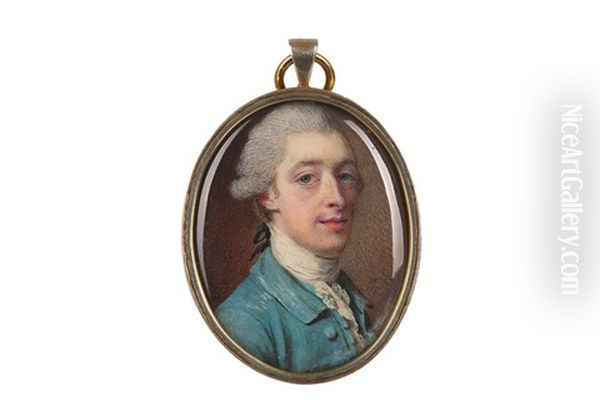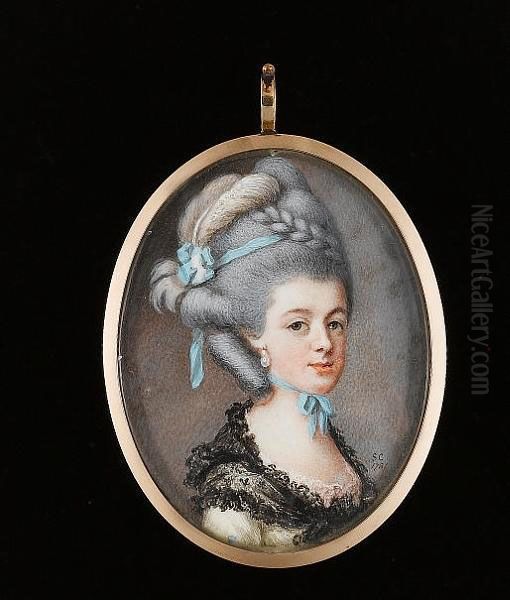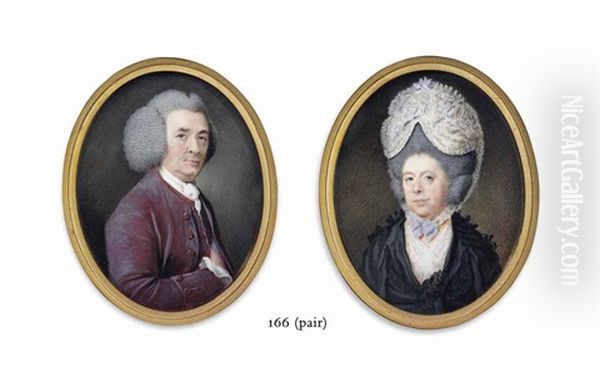Samuel Cotes (1734–1818) was a distinguished English artist who carved a significant niche for himself in the bustling art world of 18th-century London, primarily through his exquisite miniature portraits. Working during a period of great artistic flourishing and societal change, Cotes captured the likenesses of his contemporaries with a delicate touch and keen observation, leaving behind a body of work that offers intimate glimpses into Georgian society. Though perhaps sometimes overshadowed by his more famous elder brother, Francis Cotes, Samuel's contributions to the art of miniature painting and his occasional forays into pastels mark him as a noteworthy figure deserving of focused art historical attention.
Early Life and Artistic Formation in London
Born in London in 1734, Samuel Cotes emerged from a family environment that was evidently supportive of artistic pursuits. His father, Robert Cotes, was an apothecary, a profession that, while not directly artistic, placed the family within a respectable middle-class milieu of the city. London at this time was rapidly becoming a major European cultural hub, with a growing demand for portraiture fueled by an increasingly affluent populace eager to commemorate themselves and their loved ones.
The most significant early influence on Samuel was undoubtedly his elder brother, Francis Cotes (1726–1770). Francis was a preeminent portraitist of his generation, a master of both oil painting and pastels, and a founding member of the prestigious Royal Academy of Arts in 1768. It is highly probable that Samuel received his initial artistic training directly from Francis, working within his brother's studio. This apprenticeship would have provided him with a strong foundation in drawing, composition, and the handling of various media, particularly pastels, a medium in which Francis excelled. The shared artistic environment would have exposed Samuel to the latest trends, techniques, and the business side of being a professional artist in a competitive market.
The Ascendancy of the Miniature Portrait

The 18th century witnessed a remarkable vogue for miniature portraits. These small, portable likenesses served a multitude of purposes: they were intimate tokens of affection exchanged between lovers and family members, mementos of distant dear ones, and even diplomatic gifts. Their intimate scale demanded meticulous skill and a different approach to that of large-scale oil portraits. Artists like Samuel Cotes who specialized in this genre found a ready market for their talents.
Miniatures were often painted in watercolour or gouache on ivory, a support that lent a particular luminosity to the colours. They could also be executed in enamel on copper, offering greater durability. These precious objects were frequently set into elaborate lockets, brooches, snuffbox lids, or small frames, transforming them into items of personal adornment as much as works of art. The demand for such items was high among the gentry and the burgeoning middle class, who sought to emulate the fashionable practices of the aristocracy.
Samuel Cotes's Artistic Practice: Techniques and Materials
Samuel Cotes became particularly renowned for his miniatures executed in watercolour and gouache on ivory. This technique required immense patience and precision. The ivory, often a thin, translucent sheet, would be prepared, and the artist would build up the image with tiny, stippled brushstrokes or delicate washes of colour. The natural translucency of the ivory allowed light to pass through the paint layers, giving the finished portrait a jewel-like quality and a subtle inner glow, especially in the rendering of flesh tones.
While miniatures were his forte, Cotes also worked in pastels, a medium he would have mastered under his brother Francis's tutelage. Pastel portraits, typically larger than miniatures but smaller than oil paintings, offered a softness and immediacy that was highly prized. Cotes's pastels, though less numerous than his miniatures, demonstrate his versatility and his understanding of colour and texture. He also occasionally worked with enamels, a technically demanding medium involving firing pigments onto a metal base, which produced exceptionally durable and vibrant images. His proficiency across these varied media underscores his comprehensive artistic training.
Exhibitions and Professional Recognition
Samuel Cotes was an active participant in the London art scene. He began exhibiting his works in 1760, primarily with the Society of Artists, an important exhibiting body that predated the Royal Academy. He continued to show his miniatures and pastels regularly at the Society of Artists throughout the 1760s and 1770s. His consistent presence at these exhibitions helped to establish his reputation and attract clientele.

Following the founding of the Royal Academy of Arts in 1768, an institution in which his brother Francis played a key role, Samuel Cotes also began to exhibit there. He showcased his works at the Royal Academy's annual exhibitions from 1769 until 1789. This nearly three-decade span of public exhibition activity demonstrates a sustained professional career. Being accepted into these prestigious exhibitions was a mark of peer recognition and provided artists with crucial visibility to patrons and the public. His fellow exhibitors at these venues included the leading artists of the day, such as Sir Joshua Reynolds, the first President of the Royal Academy, Thomas Gainsborough, George Romney, and the Swiss-born Angelica Kauffman, another female founding member of the RA alongside Mary Moser.
Representative Works and Stylistic Characteristics
While specific titles of many of Samuel Cotes's works often follow the generic conventions of the time, such as "Portrait of a Gentleman" or "Portrait of a Lady," his oeuvre is characterized by a consistent elegance and refinement. His miniatures are typically small, often oval, and display a remarkable attention to detail, particularly in the rendering of costume, hairstyles, and jewelry, which provide valuable insights into Georgian fashion.
Cotes's style in miniature painting is marked by a delicate application of paint, subtle modeling of features, and a generally amiable and pleasing portrayal of his sitters. He had a talent for capturing a good likeness while imbuing his subjects with an air of gentle sophistication. His colour palettes are often soft and harmonious, complementing the intimate nature of the medium. Compared to some of his more flamboyant contemporaries like Richard Cosway, who often imbued his sitters with a more overtly romantic or idealized air, Cotes's approach was perhaps more straightforward and less mannered, yet always graceful. Other notable miniaturists of the period whose work provides a comparative context include John Smart, known for his precise and strong characterizations, George Engleheart, a prolific and highly successful artist, and Ozias Humphry, who also worked in pastels and oils.
His pastel works, though fewer, echo the sensitivity found in his miniatures. They demonstrate a competent handling of the medium, with soft blending and a good sense of form, clearly reflecting the influence of his brother Francis, who was a leading figure in popularizing pastel portraiture in England, following the continental example set by artists like the Venetian Rosalba Carriera. Carriera's work had a profound impact on the development of pastel painting across Europe, and her influence was certainly felt in Britain, not least through artists like Francis Cotes.
Contemporaries and the Artistic Milieu of Georgian London

Samuel Cotes operated within a vibrant and competitive artistic community. Beyond the towering figures of Reynolds and Gainsborough, London was home to a host of talented portraitists. In the specific field of miniature painting, Cotes was one among several skilled practitioners. His brother Francis Cotes was, of course, a central figure in his artistic life, not only as a mentor but also as a colleague navigating the same art world.
Samuel Cotes is also recorded as having friendships with other artists. Among them were Paul Sandby (1731–1809), a key figure in the development of English watercolour painting, particularly known for his topographical landscapes, and a founding member of the Royal Academy. Another friend was the sculptor Joseph Wilton (1722–1803), also a founding RA member, known for his monuments and portrait busts. These connections suggest Cotes was well-integrated into the artistic circles of his time.
The artistic environment was also shaped by figures like Allan Ramsay, a refined Scottish portrait painter who was a favourite of the court, and Johann Zoffany, known for his conversation pieces and theatrical portraits. The teaching and writings of artists and theorists also played a role. For instance, John Russell (1745-1806), a pupil of Francis Cotes and later a successful pastelist and miniaturist in his own right (appointed Crayon Painter to the King), documented some of Francis Cotes's pastel techniques, providing valuable insight into the methods Samuel might also have employed or adapted.
The Social Significance of Cotes's Miniatures
The miniatures produced by Samuel Cotes and his contemporaries held considerable social and personal significance. In an era before photography, these small portraits were the primary means of preserving and sharing a visual likeness. They were deeply personal items, often worn on the body or kept in private spaces.
As tokens of affection, they played a role in courtship and marriage, exchanged between betrothed couples or carried by spouses separated by travel or military service. They also served as family records, capturing the images of children as they grew, or preserving the memory of deceased loved ones. The intimacy of their scale and the preciousness of their materials (ivory, gold, jewels) imbued them with a sentimental value that often far outweighed their monetary cost.

Furthermore, owning and commissioning portraits, even small miniatures, was a marker of social status and cultural refinement. It signified that the sitter was a person of some means and sensibility, participating in the fashionable customs of the polite society of Georgian England. Samuel Cotes's clientele would have largely been drawn from this stratum of society – the gentry, professionals, military officers, and affluent merchants and their families.
Later Life, Legacy, and Misattributions
Samuel Cotes continued to work and exhibit until 1789. He lived a long life, passing away in Chelsea in 1818, nearly half a century after his more famous brother. His legacy rests primarily on his skill as a miniaturist. While he may not have achieved the same level of fame as Francis, or some of the more flamboyant miniaturists of the era, he was a consistent and respected practitioner who produced a significant body of high-quality work.
His works are held in various public and private collections, including the Victoria and Albert Museum in London, which has a significant collection of British miniatures. However, the attribution of works from this period can sometimes be challenging. It has been noted that Samuel Cotes's signature (often "S.C.") has occasionally been confused with that of other miniaturists, such as Samuel Collins of Bath (c.1735–1768) or Sarah Coote (later Hoadly), who also signed with initials. Such confusions can complicate the precise cataloguing of his oeuvre.
There is also an instance recorded where a work by Samuel Cotes was apparently misattributed as a piece by the Italian Old Master Guido Reni (1575-1642), specifically a "Madonna and Child." This likely points to a copy made by Cotes or a later misidentification, rather than a stylistic similarity, as their primary genres and styles were vastly different. It highlights the complexities that can arise in art historical research and connoisseurship.
Distinguishing Samuel Cotes: Clarifying Identities and Incidents
It is important to distinguish Samuel Cotes the artist from other individuals named Samuel Cotes or Coates who appear in historical records around the same period, as some of these individuals were associated with controversies that do not pertain to the artist.
One such figure is a "Samuel Cotes" (or "Cootes") who was involved in a peculiar and unsavory incident in 1815 concerning Christ's Hospital. This individual reportedly offered money to boys at the school to be allowed to whip them or to be whipped by them. He was deemed "eccentric and whimsical" and his conduct "immoral," but this person is distinct from the artist Samuel Cotes, who would have been around 81 years old in 1815 and whose professional career as an artist had concluded much earlier. There is no credible evidence linking the respected miniaturist to this scandal.
Similarly, a "Samuel Coates" is recorded as a missionary in Ontario, Canada, who faced persecution for his teachings but later fell into disrepute due to "lapses and bad habits." This is clearly a different individual, involved in religious activities in a different part of the world.
Finally, the term "Cotes's Spirals" in classical mechanics refers to the work of mathematician Roger Cotes (1682–1716), a contemporary of Sir Isaac Newton, or possibly a relative involved in mathematics. This scientific achievement has no connection to Samuel Cotes the artist. These distinctions are crucial to maintain an accurate biographical understanding of the painter.
Conclusion: Samuel Cotes's Place in British Art History
Samuel Cotes was a talented and diligent artist who made a notable contribution to the art of the miniature in 18th-century Britain. Working in the shadow of his highly successful brother Francis, he nevertheless established his own respected career, producing a significant number of delicate and charming portraits that captured the likenesses of his Georgian contemporaries. His work, primarily in watercolour on ivory but also encompassing pastels, reflects the technical skill and aesthetic sensibilities prized during his era.
He was an active participant in the London art world, exhibiting regularly for nearly three decades at the Society of Artists and the Royal Academy, alongside the leading figures of British art. His miniatures served important social and personal functions, acting as intimate keepsakes, symbols of affection, and markers of status. While challenges in attribution and the occasional overshadowing by more prominent names may have somewhat obscured his profile, Samuel Cotes remains an important figure for understanding the breadth and depth of portraiture in Georgian England, particularly within the specialized and highly skilled domain of the miniature. His art provides a valuable window into the faces and fashions of a bygone age, rendered with a quiet elegance that continues to appeal.